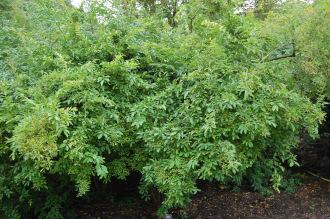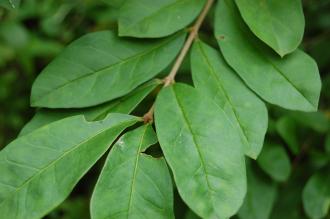
Ligustrum obtusifolium (21/09/2013, Kew Gardens, London)
Position: Full sun and partial shade
Flowering period: Late spring
Soil: Well drained soil
Eventual Height: 3m
Eventual Spread: 4m
Hardiness: 4a, 4b, 5a, 5b, 6a, 6b, 7a, 7b, 8a, 8b, 9a
Family: Oleaceae
Ligustrum obtusifolium is a semi-evergreen shrub with a bushy habit. Its glossy dark green leaves are elliptic with entire margins, up to 6cm long and 25mm broad. Its white flowers are small and tubular and appear as short terminal panicles which are up to 4cm long. These are followed by ellipsoid green drupe which are up to 6mm across and mature to purple/ black.

Ligustrum obtusifolium Leaf (21/09/2013, Kew Gardens, London)
Ligustrum obtusifolium, commonly known as the Border Privet, is native to east China, Japan and Korea. In its native habitat it grows in thickets or woodlands.
The etymological root of the binomial name Ligustrum was an old name for the Privet plant. Obtusifolium is derived from the Latin obtusus meaning ‘blunt’ andfolium
The landscape architect may find Ligustrum obtusifolium useful as an evergreen hedge. It may be pruned to produce a formal or flowering informal form.
Ecologically, Ligustrum obtusifolium flowers are attractive to many species of pollinating insects. It fruit are attractive to some species of birds.

Ligustrum obtusifolium Berry (21/09/2013, Kew Gardens, London)
Ligustrum obtusifolium prefers moist, fertile, well-drained soils. It tolerates most pH of soil.
If maintaining Ligustrum obtusifolium as a hedge, formal or informal, it plant should be trimmed after flowering.

